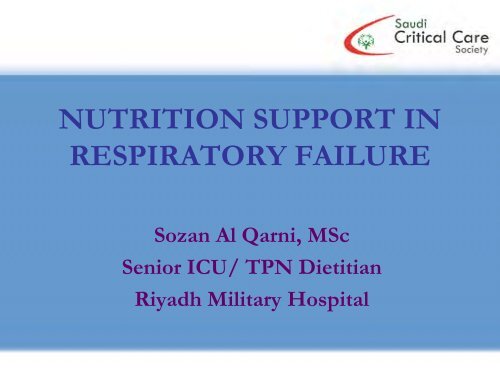NUTRITION SUPPORT IN RESPIRATORY FAILURE - RM Solutions
NUTRITION SUPPORT IN RESPIRATORY FAILURE - RM Solutions NUTRITION SUPPORT IN RESPIRATORY FAILURE - RM Solutions
NUTRITION SUPPORT INRESPIRATORY FAILURESozan Al Qarni, MScSenior ICU/ TPN DietitianRiyadh Military Hospital
- Page 2 and 3: EPIDEMOLOGY
- Page 4 and 5: Incidence & PrevalenceAuthor Countr
- Page 6 and 7: Malnutrition In COPDMechanically Ve
- Page 8 and 9: Malnutrition Indicators in ICUWeigh
- Page 10 and 11: Malnutrition Indicators in ICUR.B.P
- Page 12 and 13: When to start NutritionSupport?•
- Page 14 and 15: Aggressive NutritionSupportReduce M
- Page 16 and 17: Calories RequirmentIndirectcalorime
- Page 18 and 19: CaloriesUse Adjusted BWT if BMI ≥
- Page 20 and 21: Fat• IV. Fat emulsions influence
- Page 22 and 23: Vitamins & MineralsSupplement(Ph+4,
- Page 24 and 25: low bone mineral density In COPD is
- Page 26 and 27: Supplement (Ph+4)Reduce duration of
- Page 28 and 29: FluidFluid overloadPulmonarycongest
- Page 30 and 31: Oral RouteSmall foodvolumeLimited a
- Page 32 and 33: Tube Feeding•Insufficient oral in
- Page 34 and 35: Feed untollerance- Diarrhea- Decrea
- Page 36 and 37: SummaryASPEN Practice guidelines fo
<strong>NUTRITION</strong> <strong>SUPPORT</strong> <strong>IN</strong><strong>RESPIRATORY</strong> <strong>FAILURE</strong>Sozan Al Qarni, MScSenior ICU/ TPN DietitianRiyadh Military Hospital
EPIDEMOLOGY
Incidence & Prevalence• Rates increase with age• Prevalence higher in men but totalmortality is similar in both sexes• Higher in whites• Higher in fewer years of formal education(Girgorakos L etal, 2003)
Incidence & PrevalenceAuthor Country Respiratory Diseases YearCanadian LungAssociation. HealthCanadaCanadaThird leading cause of hospitaladmission& death2001The burden ofrespiratory disease.U KResponsible for 6.5% of allhospital admissions1991-1992National Institutes ofHealthUSA Fourth leading cause of death 1991 _1992Omar Al Amodi KSA COPD & Pneumonia leadingcause of hospital admission1996 - 2000
Malnutrition In COPD• More >30% of patients with COPD haveP.E.M• Loss of weight in late stage of COPDCOPD:Coronic obtructive pulmonary diease, PEM: protien Energy Malnutrtion(Girgorakos L etal, 2003)
Malnutrition In COPDMechanically Ventilated (MV)Patients are iatrogenic in ICUDelayedalimentationinitiationHoldingE.NFeeduntolleranceMetaboliclimitationEN:Enteral Nutrition(Villets etal, 2005)
ContentsPreface ........................................................................................ iiiFigures ........................................................................................ ixTables ......................................................................................... xiSummary.....................................................................................xiiiAcknowledgments ........................................................................... xixGlossary...................................................................................... xxiCHAPTER ONESustainment of Army Units in OIF...........................................................1Sustainment Performance in OIF..............................................................3A Joint Supply Chain Vision ..................................................................7Tactical Supply Operations..................................................................8Theater Distribution....................................................................... 10Strategic Distribution...................................................................... 10Theater General Support Stockage ........................................................ 12National Supply Management............................................................. 13Command and Control.................................................................... 13The OIF Supply Chain ...................................................................... 14Organization of This Report................................................................. 18CHAPTER TWOTactical Supply Operations ................................................................. 19A Few Basic Army Inventory Metrics and Terms ........................................... 19Prepositioned ASL Breadth: Did the Army Preposition the Right Parts? ................... 21ASLs Deployed from CONUS Had Better Part Mixes...................................... 25ASLs Were Quickly Depleted ............................................................... 28Part Ordering During Combat Operations.................................................. 30Recommendations ........................................................................... 32v
Malnutrition Indicators in ICUWeight lose from illness ≥10% of the UBW
Malnutrition Indicators in ICUDecrease Anthropometric IndicatorsSubcutaneous fatstorsMAMCCHIMAMC: Mid Arm Muscl circumference,CHI; Creatinine Hieght Index(Villets etal, 2005)
Malnutrition Indicators in ICUR.B.PAlbuminDecrease serumlevelsPre-albuminRBP: Retinol Binding Protein
Malnutrition Indicators in ICUHypo-albuminemia related to poor outcomeIncrease L.O.SSeverity of illnessDegree of lungdysfunctionLOS: Length Of Stay
When to start NutritionSupport?• Each patient beconsidered Individually• Start as the patientHemodynamicallystable• Protocol of EN to reduceMortality( Doige GS et al 2008)
Goal of Nutrition Support• Meet metabolic & protein needs• Limiting wasting of respiratory muscles• Restore health & baseline pulmonaryfunction(Villets etal, 2005)
Aggressive NutritionSupportReduce Mortality RateL.O.SImprove Respiratorymuscle strengthWell-beingDyspniea
Nutrition Requirements
Calories RequirmentIndirectcalorimetry(25-30kcal/Kg/d)(1.3 x REE)(ASPEN& ESPEN 2010)(Anbar et al 2009)(Martindelet al 2009)
Calories• Use Acual BWT if BMI < 20to prevent over feeding• Increase calories intake above REE after weaningfrom M.V. to promote positive nitrogen balance &replet nutrition deficits.BMI: Body mass index, BWT: Body Weight(ASPEN& ESPEN 2010)(Anbar et al 2009)(Martindelet al 2009)
CaloriesUse Adjusted BWT if BMI ≥3011 – 14 kcal/IBW/day22 – 25 Kcal/IBW/day21 Kcal/Acual BW/day(ASPEN& ESPEN 2010)(Anbar et al 2009)(Martindelet al 2009)
Protein• (1.2 – 1.5 gm /Kg/day)(Actual or IBW whichever in lower for stress orrepletion)• ( 1.3 – 2 gm/Kg/day)(Post lung transplant)• Supplement Argenin & Glutamin• Replace protein loss in the urineIBW:Ideal Body Weight)(ASPEN& ESPEN 2010)(Anbar et al 2009)(Martindelet al 2009)
Fat• IV. Fat emulsions influence respiratoryfunction• Consider calories driven from propofol(ASPEN& ESPEN 2010)(Anbar et al 2009)(Martindelet al 2009)
FatOmega 3 f.a.a & linoleic acid Enhanceproduction-Alveolar ventilation-Pulmonary perfusion ratio-Vasodilating prostanoids-LOS
Vitamins & MineralsSupplement(Ph+4, Fe++ , vitamin A, C, E, Selenium, Mg++,Ca++)(ASPEN& ESPEN 2010)(Anbar et al 2009)(Martindelet al 2009)
Supplement AntioxidantsMeet demands of excessive free radicalproductionsVitamine uptakeMobilization forpatients with R.FRF: Respitatory Failure(ASPEN& ESPEN 2010)(Anbar et al 2009)(Martindelet al 2009)
low bone mineral density In COPD is due toPulmonary disease processGlucocorticosteroid TherapyReduced physical activitiesInadequate intake ofVitamin D & Ca++Long term smoking24
Decrease contractilityof respiratory musclesSevereHypophosphatemiaDecrease O2 deliveryNeuromusculardysfunctionReduce level of 2,3diphosphoglyceratein red cellsExacerbatepulmonary failure
Supplement (Ph+4)Reduce duration of M.VImprove muscle weaknessReduce L.O.S
Fluid• Moderate to severe fluid restriction• Fluid management in ARDS should be adjustedbased on current status(ASPEN& ESPEN 2010)
FluidFluid overloadPulmonarycongestionEdemapoor lungfunction
Nutrition Interventions29
Oral RouteSmall foodvolumeLimited abdominal distensionMinimize upward pressureon the diaphragmReduce sensationto dyspinea
Oral Route• Increase Caloric intake to 150% of BEE• Increase CHO loads up to 300 gm/ meal• High fat 50% supplement to reduce CO2production
Tube Feeding•Insufficient oral intake•PEG to prevent aspiration &high gastric residual volume•Fine bore feeding tube tominimize aspiration•Raise H.O.B. at ( 30 - 45˚)•Restrictive feed volumePEGPercutaneous Endoscopic Gastrostomy , HOB: Head Of the Bed, (ASPEN& ESPEN 2010)
Tube Feeding• Rich with EPA & gammalinoleicacids• Low NA+ in P.E.• Low CHO rich formulas• Reduce (F/R) during weaning• Document adequacy of oralintake before discontinuing tubeNA: soduim, CHO: Charbohydrat, F/R: flow Rate) (ASPEN& ESPEN 2010)
Feed untollerance- Diarrhea- Decrease bowel sound- Abdominal distensionUse ofAnta acid therapyMedication containing sorbitol
P.N.• Inadequate GI function.• Concentrated P.N. Solution incase of fluid restriction.• Add electrolytes, vitamins &minerals as appropriate.• Transit to E.N. as G.I.Function improves(ASPEN& ESPEN 2010)
SummaryASPEN Practice guidelines for respiratoryfailure:• COPD or ARDS are at nutrition risk• Energy intake below estimated needs• Use EN containing n-3 fatty acids• Fluid restriction• Monitor serum ph+4 level closelyAfter 28 days in ICU(ASPEN& ESPEN 2010)
Thank YOU



